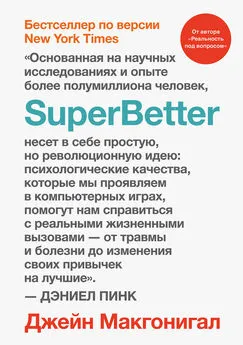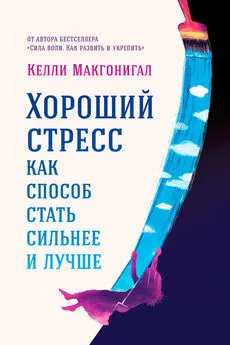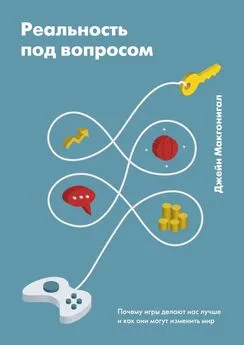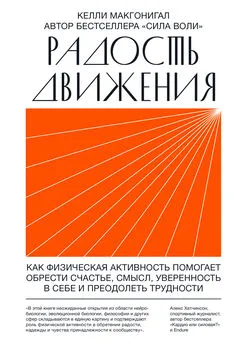Джейн Макгонигал - SuperBetter
- Название:SuperBetter
- Автор:
- Жанр:
- Издательство:Манн, Иванов и Фербер
- Год:2018
- Город:Москва
- ISBN:9785001174301
- Рейтинг:
- Избранное:Добавить в избранное
-
Отзывы:
-
Ваша оценка:
Джейн Макгонигал - SuperBetter краткое содержание
Книга будет интересна всем, кто готов освоить игровой подход для решения повседневных задач.
SuperBetter - читать онлайн бесплатно полную версию (весь текст целиком)
Интервал:
Закладка:
85
Andrew K. Przybylski et al. Competence-Impeding Electronic Games and Players’ Aggressive Feelings, Thoughts, and Behaviors // Journal of Personality and Social Psychology. 2014. № 106 (3). P. 441–457.
86
Robert Mihan, Yvonne Anisimowicz, Richard Nicki . Safer with a Partner: Exploring the Emotional Consequences of Multiplayer Video Gaming // Computers in Human Behavior. 2015. № 44. P. 299–304.
87
Шутер (стрелялки) — жанр видеоигр, в котором упор сделан на скорость реакции геймера и командное взаимодействие.
88
Pamela M. Kato et al. A Video Game Improves Behavioral Outcomes in Adolescents and Young Adults with Cancer: A Randomized Trial // Pediatrics. 2008. № 122 (2). e305–e317.
89
Richard Tate, Jana Haritatos, Steve Cole . HopeLab’s Approach to Re-Mission // International Journal of Learning and Media. 2009. № 1 (1). P. 29–35.
90
Автор ссылается на социально-когнитивную теорию научения Альберта Бандуры. Термин означает веру в эффективность собственных действий и ожидание успеха от их реализации. Близкое к самоэффективности понятие — уверенность в себе. Прим. науч. ред.
91
Hye-Sue Song, Paul M. Lehrer . The Effects of Specific Respiratory Rates on Heart Rate and Heart Rate Variability // Applied Psychophysiology and Biofeedback. 2003. № 28 (1). P. 13–23; Paul M. Lehrer . Biofeedback Training to Increase Heart Rate Variability // Principles and Practice of Stress Management. 2007. № 3. P. 227–248.
92
Jeffrey J. Goldberger et al. Relationship of Heart Rate Variability to Parasympathetic Effect // Circulation. 2001. № 103 (15). P. 1977–1983; Harald M. Stauss . Heart Rate Variability // American Journal of Physiology-Regulatory, Integrative and Comparative Physiology. 2003. № 285 (5). R927–R931.
93
Matthias J. Koepp et al. Evidence for Striatal Dopamine Release During a Video Game // Nature. 1998. № 393 (6682). P. 266–268.
94
Matilda Hellman et al. Is There Such a Thing as Online Video Game Addiction? A Cross-Disciplinary Review // Addiction Research and Theory. 2013. № 21 (2). P. 102–112; Florian Rehbein et al. Prevalence and Risk Factors of Video Game Dependency in Adolescence: Results of a German Nationwide Survey // Cyberpsychology, Behavior, and Social Networking. 2010. № 13 (3). P. 269–277; Antonius J. Van Rooij et al. Online Video Game Addiction: Identification of Addicted Adolescent Gamers // Addiction. 2011. № 106 (1). P. 205–212; Douglas Gentile . Pathological Video-Game Use Among Youth Ages 8 to 18 a National Study // Psychological Science. 2009. № 20 (5). P. 594–602.
95
Irma Triasih Kurniawan, Marc Guitart-Masip, Ray J. Dolan . Dopamine and Effort-Based Decision Making // Frontiers in Neuroscience. 2011. № 5.
96
M. E. Walton et al. Weighing Up the Benefits of Work: Behavioral and Neural Analyses of Effort-Related Decision Making // Neural Networks. 2006. № 19 (8). P. 1302–1314; Michael T. Treadway et al. Worth the ‘EEfRT’? The Effort Expenditure for Rewards Task as an Objective Measure of Motivation and Anhedonia // PLOS ONE. 2009. № 4 (8). e6598.
97
Michael T. Treadway et al. Dopaminergic Mechanisms of Individual Differences in Human Effort-Based Decision-Making // Journal of Neuroscience. 2012. № 32 (18). P. 6170–6176.
98
Marie-Laure Cléry-Melin et al. Why Don’t You Try Harder? An Investigation of Effort Production in Major Depression // PLOS ONE. 2011. № 6 (8). e23178.
99
Loan T. K. Vo et al. Predicting Individuals’ Learning Success from Patterns of Pre-Learning MRI Activity // PLOS ONE. 2011. № 6 (1). e16093; Caterina Breitenstein et al. Hippocampus Activity Differentiates Good from Poor Learners of a Novel Lexicon // NeuroImage. 2005. № 25 (3). P. 958–968; Roy A. Wise . Dopamine, Learning and Motivation // Nature Reviews Neuroscience. 2004. № 5 (6). P. 483–494.
100
Джейн Макгонигал . Реальность под вопросом. Почему игры делают нас лучше и как они меняют мир. М.: Манн, Иванов и Фербер, 2018.
101
Matthew Ventura, Valerie Shute, and Weinan Zhao. The Relationship Between Video Game Use and a Performance-Based Measure of Persistence // Computers and Education. 2013. № 60 (1). P. 52–58.
102
Treadway et al. Dopaminergic Mechanisms of Individual Differences.
103
Simone Kühn et al. The Neural Basis of Video Gaming // Translational Psychiatry. 2011. № 1 (11). e53.
104
Simone Kühn et al. Playing Super Mario Induces Structural Brain Plasticity: Gray Matter Changes Resulting from Training with a Commercial Video Game // Molecular Psychiatry. 2013. № 19. P. 265–271.
105
C. Shawn Green, Daphne Bavelier . The Cognitive Neuroscience of Video Games / In P. Messaris and L. Humphreys, eds., Digital Media: Transformations in Human Communication. New York: Peter Lang, 2006. P. 211–223; Matthew W. G. Dye, C. Shawn Green, Daphne Bavelier . Increasing Speed of Processing with Action Video Games // Current Directions in Psychological Science. 2009. № 18 (6). P. 321–326; C. Shawn Green, Alexandre Pouget, Daphne Bavelier. Improved Probabilistic Inference as a General Learning Mechanism with Action Video Games // Current Biology. 2010. № 20 (17). P. 1573–1579.
106
Daphne Bavelier et al. Removing Brakes on Adult Brain Plasticity: From Molecular to Behavioral Interventions // Journal of Neuroscience. 2010. № 30 (45). P. 14964–14971.
107
Daniela Oltea JOJA . Learning Experience and Neuroplasticity — A Shifting Paradigm // Nature Reviews Neuroscience. 2002. № 3 (1). P. 65–71.
108
Steven W. Cole, Daniel J. Yoo, Brian Knutson . Interactivity and Reward-Related Neural Activation During a Serious Videogame // PLOS ONE. 2012. № 7 (3). e33909; Jari Kätsyri et al. The Opponent Matters: Elevated fMRI Reward Responses to Winning Against a Human Versus a Computer Opponent During Interactive Video Game Playing // Cerebral Cortex. 2013. № 23 (12). P. 2829–2839; Klaus Mathiak, René Weber. Toward Brain Correlates of Natural Behavior: fMRI During Violent Video Games // Human Brain Mapping. 2006. № 27 (12). P. 948–956; Keiichi Saito, Naoki Mukawa, Masao Saito . Brain Activity Comparison of Different-Genre Video Game Players // Second International Conference on Innovative Computing, Information and Control ICICIC ’07 (IEEE, 2007); Martin Klasen et al. Neural Contributions to Flow Experience During Video Game Playing // Social Cognitive and Affective Neuroscience. 2012. № 7 (4). P. 485–495; Jari Kätsyri et al. When Just Looking Ain’t Enough: Phasic fMRI Reward Responses During Playing Versus Watching a Video Game // Frontiers in Psychology. 2013.
109
Игра, в которой случайным образом выбираются числа, а участники должны заполнять соответствующие числа на своих карточках. Первый участник, заполнивший карточку в соответствии с правилами розыгрыша, побеждает. Прим. ред.
110
Викарный (vicarious) — замещающий, имеющий отношение или выполняющий функции замещения. Этот термин используется в медицине для описания структуры или функции какого-либо органа, которые обычно этому органу не присущи и действуют как заместительные.
111
Jesse Fox, Jeremy N. Bailenson . Virtual Self-Modeling: The Effects of Vicarious Reinforcement and Identification on Exercise Behaviors // Media Psychology. 2009. № 12 (1). P. 1–25.
112
Jeremy N. Bailenson. Doppelgangers — A New Form of Self? // Psychologist. 2012. № 25 (1). P. 36–38.
113
Jesse Fox, Jeremy N. Bailenson . The Use of Doppelgängers to Promote Health Behavior Change // Cybertherapy and Rehabilitation. 2010. № 3 (2). P. 16–17.
114
Robin S. Rosenberg, Shawnee L. Baughman, Jeremy N. Bailenson . Virtual Superheroes: Using Superpowers in Virtual Reality to Encourage Prosocial Behavior // PLOS ONE. 2013. № 8 (1). e55003.
115
Leif D. Nelson, Michael I. Norton . From Student to Superhero: Situational Primes Shape Future Helping // Journal of Experimental Social Psychology. 2005. № 41 (4). P. 423–430.
116
Rune Aune Mentzoni et al. Problematic Video Game Use: Estimated Prevalence and Associations with Mental and Physical Health // Cyberpsychology, Behavior, and Social Networking. 2011. № 14 (10). P. 591–596; Douglas A. Gentile et al. Pathological Video Game Use Among Youths: A Two-Year Longitudinal Study // Pediatrics. 2011. № 127 (2). e319–e329; Douglas Gentile. Pathological Video Game Use Among Youth Ages 8 to 18: A National Study // Psychological Science. 2009. № 20 (5). P. 594–602.
117
Lily Shui-Lien Chen, Hill Hung-Jen Tu, Edward Shih-Tse Wang . Personality Traits and Life Satisfaction Among Online Game Players // Cyberpsychology and Behavior. 2008. № 11 (2). P. 145–149; Patricia E. Kahlbaugh et al. Effects of Playing Wii on Well-Being in the Elderly: Physical Activity, Loneliness, and Mood // Activities, Adaptation and Aging. 2011. № 35 (4). P. 331–344; Younbo Jung et al. Games for a Better Life: Effects of Playing Wii Games on the Well-Being of Seniors in a Long-Term Care Facility // Proceedings of the Sixth Australasian Conference on Interactive Entertainment. 2009. ACM; Mark Griffiths . Video Games and Health: Video Gaming Is Safe for Most Players and Can Be Useful in Health Care // BMJ: British Medical Journal. 2005. № 331 (7509). 122 p.; Jason C. Allaire et al. Successful Aging Through Digital Games: Socioemotional Differences Between Older Adult Gamers and Non-Gamers // Computers in Human Behavior. 2013. № 29 (4). P. 1302–1306.
118
Laura M. Padilla-Walker et al. More Than a Just a Game: Video Game and Internet Use During Emerging Adulthood // Journal of Youth and Adolescence. 2010. № 39 (2). P. 103–113; Vivek Anand . A Study of Time Management: The Correlation Between Video Game Usage and Academic Performance Markers // Cyberpsychology and Behavior. 2007. № 10 (4). P. 552–559.
Читать дальшеИнтервал:
Закладка:








